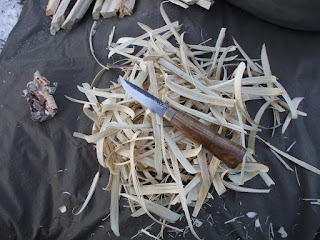First prize - The Collins head, in as is condition. Not sharpened, not de-rusted. It is what it is.
Second Prize - The Double Bit. Doesn't look used much at all. Could be K-mart, Could be the holy grail. Who knows?
Third Prize - Magnesium block and striker. Not the best, not the worst, brand new. From Harbor Freight.
The Winners will be announced on Thanksgiving Day, 2010.
To cast your vote for the winning article, send and email with the article name in the subject line to : thesharpenedaxe@hotmail.com
Our first article for the contest comes from bmatt, a regular contributor here on "The Axe". I always look forward to reading his stuff, and this article is no exception.
The Split-Wood Fire, by bmatt, an American Bushcrafter in Finland
Having a fire in the outdoors can be a wonderful thing. It can cook your food, keep you warm and raise your spirits. Getting a fire going can be a challenge though, especially in wet weather. Sometimes, the only dry wood to be found is located inside logs which are wet on the outside. That means you’re going to have to split the wood to get at it. This not only provides you with dry wood, but also wood that burns better because of its shape: Split wood has a lot more angles, splinters etc., which burn better than smooth, round wood.
Last winter, I took a short trip to the woods and brought along a Finnish-made Roselli axe (I have since traded this axe, but still think it’s a very versatile and powerful tool). As you can see, the conditions were not wet, but it was cold, which can also make fire lighting more difficult at times.
I started by bucking (sectioning) a 6”-diameter pine log. As you can see, I chopped into the log at a 45-degree angle and made a nice wide cut. I’ll write more about bucking (and felling) trees a little later.
I took the log section over to my fire pit and cut it in half with a saw. I could have done this with the axe, though.
The next task was to split the log into progressively smaller pieces, first in half, then in quarters, etc. My favorite way to do this in the bush is to place a small support log directly between my feet “horizontally”, i.e. with an end at each foot. I then lean the wood I want to chop against the support log (perpendicularly as seen from above) so that I can split it, either by striking it on the side or on the end (which determines whether the wood to be split will be placed “in front of you” or “behind you”). Be careful where you strike the log to avoid it flying up into your face! When you get down to small enough pieces of wood, you can split them by holding a piece in one hand, placing the edge of the axe onto the side of the wood and then bringing them down together on a stable log. This will force the axe through the wood on impact.
Once the splitting is done, I like to make a nice big pile of shavings from the split wood. This makes good tinder when nothing else is available. You can also make “feather sticks”, which is essentially the same thing, except with the shavings still attached to the stick. At this point, I would recommend making a small platform out of wood on the wet or snowy ground. I didn’t do it in this case, because it wasn’t wet and because I had dug down to the frozen ground. Place your shavings in the center of the platform, lay on your smallest pieces of split wood (I use pencil-sized pieces), and light the shavings from the bottom.
When the shavings and sticks are burning nicely, I slowly add wood, gradually moving from smaller to larger pieces, until I can finally add my large fuel wood, which I prefer to lay on “log cabin” style. Remember to not add wood too quickly, or you can smother the fire.
There are many ways to start a fire using different materials, and many different configurations of fire for different purposes as well. This is just one example. Hope you found it useful!
Pax Domini Sit Semper Vobiscum,
Mike, Oscar, Hotel....out.
















Great Blog, I enjoyed reading this.
ReplyDeleteThanks, Bob. :)
ReplyDeletebmatt
Hello,
ReplyDeleteI see you are using Roselli's piilukirves. Piilukirves is a traditional Finnish axe form and can be translated as carving axe. While generally this translation holds true it could just as well be construed as hewing axe as the larger versions of this form of axe were used for rough hewing round logs for use in building construction. Smaller piilukirves were used specifically for trimming the inside walls of log houses as a way of exposing fresh wood after soot from the fire had blackened the walls. The overly thick cheeks of the axe provide extra mass which aids in the action needed to make smooth cuts perpendicular to the log's axis but mislead many people into thinking the axes are intended for splitting wood.
Greetings,
Don Wagstaff